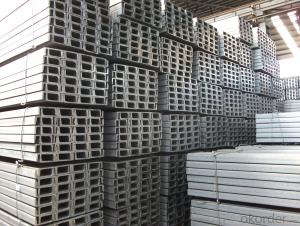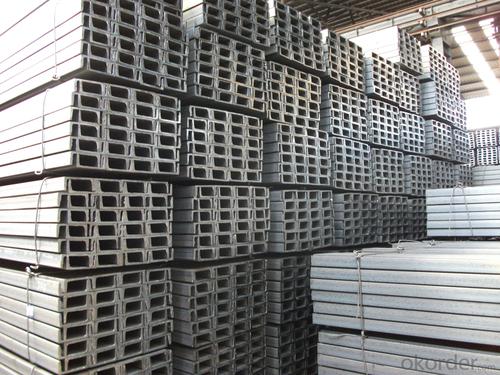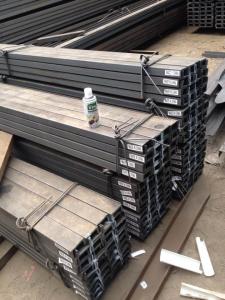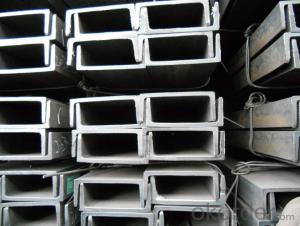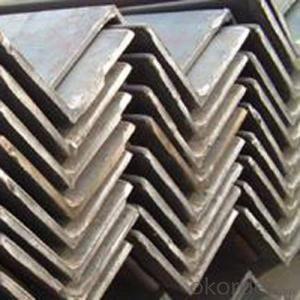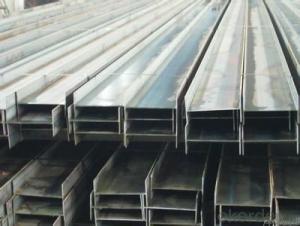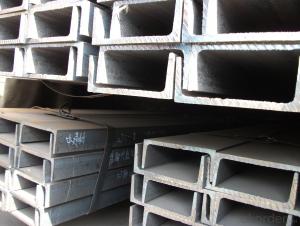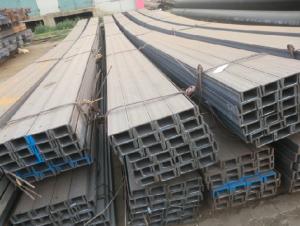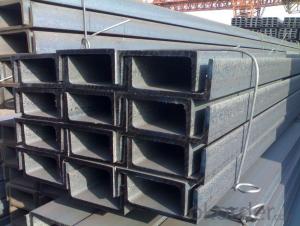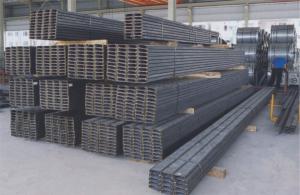Hot Rolled Steel U Channel
- Loading Port:
- China Main Port
- Payment Terms:
- TT or LC
- Min Order Qty:
- -
- Supply Capability:
- -
OKorder Service Pledge
OKorder Financial Service
You Might Also Like
Product Description:
OKorder is offering high quality Channel Steel at great prices with worldwide shipping. Our supplier is a world-class manufacturer of steel, with our products utilized the world over. OKorder annually supplies products to European, North American and Asian markets. We provide quotations within 24 hours of receiving an inquiry and guarantee competitive prices.
Product Applications:
Channel Steel is usually used for building structure, vehicle manufacturing and other industrial structure and often used with i beam.
In details, the channel steel belongs to carbon structural steel which is applied to in the field of construction and machinery. The channel steel is usually used for arch-itechtural structure, and they could be welded in order to support or hang a vari-ety of facilities. They are also usually used in combination with I beam. Generally,the channel steel must possess perfect welding property, riveting property and mechanical property and so on.
Product Advantages:
OKorder's Channel Steel are durable, strong, and resist corrosion.
Main Product Features:
· Premium quality
· Prompt delivery & seaworthy packing (30 days after receiving deposit)
· Corrosion resistance
· Can be recycled and reused
· Mill test certification
· Professional Service
· Competitive pricing
Product Specifications:
| Original Place | Tangshan, China | Brand Name | Bridge |
| Standard | GB707-88, EN100025, JIS G3192, DIN 1026 | ||
| Sizes | 50mm to 300mm | ||
| Sales Volume/Year | 3000MT | ||
| Main Market | Middle East, Africa, Southeast As | ||
1.We are able to provide channel steel of top quality at attractive price.
2.Our products of channel steel have passed ISO9001:2008 Quality Management System Certification.
3. The section of JIS Standard Channel Steel are as followings in the table.
| JIS U CHANNEL | Standard h | Sectional b | Dimension s | t | Mass: Kg/m |
| (mm) | (mm) | (mm) | (mm) | ||
| 50x25 | 50 | 25 | 3.0 | 6.00 | 2.37 |
| 75X40 | 75 | 40 | 3.8 | 7.00 | 5.30 |
| 75X40 | 75 | 40 | 4.0 | 7.00 | 5.60 |
| 75X40 | 75 | 40 | 4.5 | 7.00 | 5.85 |
| 75X40 | 75 | 40 | 5.0 | 7.00 | 6.92 |
| 100X50 | 100 | 50 | 3.8 | 6.00 | 7.30 |
| 100X50 | 100 | 50 | 4.2 | 6.00 | 8.03 |
| 100X50 | 100 | 50 | 4.5 | 7.50 | 8.97 |
| 100X50 | 100 | 50 | 5.0 | 7.50 | 9.36 |
| 125X65 | 125 | 65 | 5.2 | 6.80 | 11.66 |
| 125X65 | 125 | 65 | 5.3 | 6.80 | 12.17 |
| 125X65 | 125 | 65 | 5.5 | 8.00 | 12.91 |
| 125X65 | 125 | 65 | 6.0 | 8.00 | 13.40 |
| 150x75 | 150 | 75 | 5.5 | 7.30 | 14.66 |
| 150x75 | 150 | 75 | 5.7 | 10.00 | 16.71 |
| 150x75 | 150 | 75 | 6.0 | 10.00 | 17.90 |
| 150x75 | 150 | 75 | 6.5 | 10.00 | 18.60 |
4. Chemical Compostion of JIS Standard Channel Steel
| Grade | Element(%) | |||
| C | Mn | P | S | |
| SS330 | -- | -- | ≦0.050 | ≦0.050 |
| SS400 | ||||
| SS490 | ||||
| SS540 | ≦0.30 | ≦1.60 | ≦0.040 | ≦0.040 |
Package & Delivery of Channel Steel:
The steel u channel will be packed in bundle with steel wire at each end of every bundle and color marking in order to help the customer to recognize his goods more easily at sight.
And steel u channel could be loaded into 20ft or 40ft container, or by bulk cargo. If the weight of each bundle reaches less than 3.5 mt, the loading by break bulk cargo should be choosed. When the weight of each bundle reaches less than 3mt, the loading by container should be choosed.
As for the transportaion from mill to loading port, the truck will be usually used. And the maximum quantity for each truck is 40mt.
All in all, we could do in accordance with customer's request.
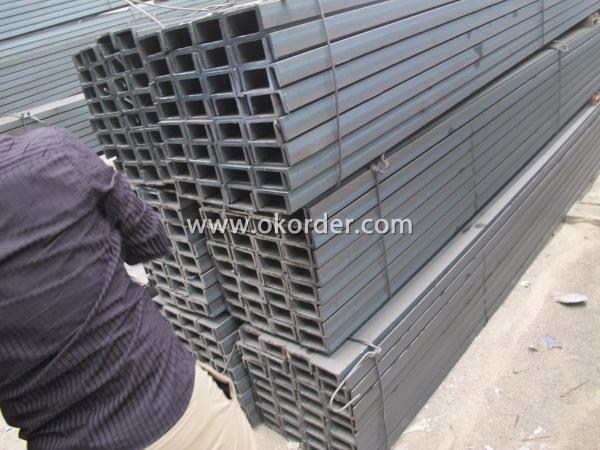
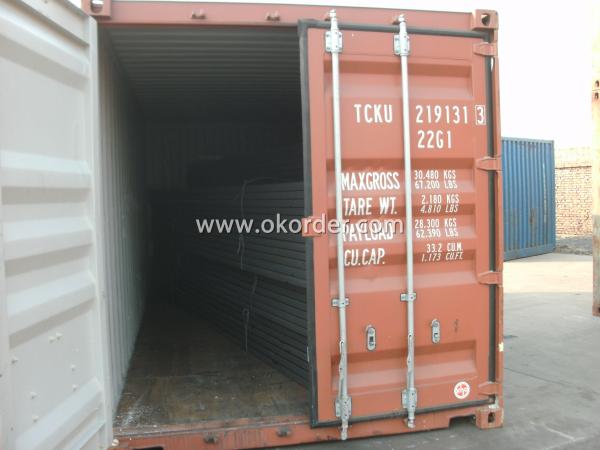
Production Flow of Channel Steel:
1.The steel billet shall be heated in the high temperature furnace.
2. The heated steel billet shall be rolled five to nine times with the aim of shaping the general figure of steel u channel.
3. The rolled steel u channel should be put onto the cooling bed to make the temperature low.
4. The steel u channel should be straighted on the straightener.
5. The straighted steel u channel will be cut into meters by saw, as per customer's requirements.
FAQ:
Q1: Why buy Materials & Equipment from OKorder.com?
A1: All products offered byOKorder.com are carefully selected from China's most reliable manufacturing enterprises. Through its ISO certifications, OKorder.com adheres to the highest standards and a commitment to supply chain safety and customer satisfaction.
Q2: How do we guarantee the quality of our products?
A2: We have established an advanced quality management system which conducts strict quality tests at every step, from raw materials to the final product. At the same time, we provide extensive follow-up service assurances as required.
Q3: How soon can we receive the product after purchase?
A3: Within three days of placing an order, we will begin production. The specific shipping date is dependent upon international and government factors, but is typically 7 to 10 workdays.
- Q: What are the applications of steel channels?
- Steel channels have a wide range of uses in different industries and sectors. In the construction industry, they are commonly employed as structural components in building frames, bridges, and other infrastructure projects. Steel channels offer strength, stability, and load-bearing capacity, making them suitable for supporting heavy loads and enduring environmental factors like wind, earthquakes, and extreme temperature changes. Besides construction, the manufacturing industry also extensively utilizes steel channels. They are often incorporated into the production of machinery, equipment, and vehicles. Steel channels can be employed as support structures in manufacturing plants and in the fabrication of frames, conveyors, and racks. Their high strength-to-weight ratio makes them ideal for such applications. In the renewable energy sector, steel channels play a crucial role, particularly in the construction of solar panel mounting systems and wind turbine towers. Thanks to their durability and resistance to corrosion, steel channels provide a dependable and sturdy framework for these renewable energy installations. Furthermore, the automotive industry frequently employs steel channels. They are used in the chassis and body frames of automobiles to ensure structural integrity and enhance safety. The strength and rigidity of steel channels make them vital components for maintaining vehicle stability and performance. Additionally, steel channels are utilized in the manufacturing of storage systems like shelving, racking, and warehouse systems. They provide a robust framework for organizing and storing products in various commercial and industrial settings. Overall, the applications of steel channels are vast and diverse, spanning from construction and manufacturing to renewable energy and automotive industries. Their strength, durability, and versatility make them indispensable components in numerous sectors, contributing to the development of robust and reliable structures and equipment.
- Q: How is a steel channel made?
- Hot rolling is the typical method used to produce a steel channel. The process commences by heating a large rectangular steel billet until it reaches a malleable temperature. Subsequently, the billet is passed through a sequence of rollers that gradually transform it into the desired channel shape. Throughout the hot rolling process, the rollers continually squeeze and elongate the billet, resulting in a reduction in thickness and an increase in length. The final shape of the channel is determined by the grooves on the rollers. The channel section can range from a simple C-shape to more intricate U-shapes or even customized profiles. As the billet takes shape, any surplus material is expelled through the sides, leaving behind a well-defined and clean channel shape. To prevent warping or distortion during the rolling process, the channel is consistently cooled. Once the desired length is attained, the channel is cut into individual pieces according to the specific requirements of the customer. Following the hot rolling process, additional treatments may be applied to the steel channels, such as straightening, surface cleaning, or coating. These treatments ensure that the channels meet the desired specifications and are ready for use in various applications, including structural support, construction, and manufacturing. In summary, the hot rolling process plays a vital role in the production of steel channels, enabling the fabrication of sturdy and adaptable structural components that find application in multiple industries.
- Q: What are the different surface protection techniques for steel channels?
- There are several different surface protection techniques for steel channels, including galvanization, powder coating, epoxy coating, and painting. Galvanization involves applying a layer of zinc to the surface of the steel to protect it from corrosion. Powder coating involves applying a dry powder to the steel and then heating it to create a durable and protective coating. Epoxy coating involves applying a layer of epoxy resin to the surface of the steel, which provides excellent resistance to chemicals and corrosion. Painting involves applying a layer of paint to the steel, which not only enhances its appearance but also provides some level of protection against rust and corrosion.
- Q: Can steel channels be customized for specific applications?
- Yes, steel channels can be customized for specific applications. Steel channels are versatile and can be fabricated and modified to meet the specific requirements of different applications. Customization can involve altering the dimensions, shape, or material composition of the steel channel to suit the needs of the application. Additionally, various surface finishes and coatings can be applied to the steel channels to enhance their performance and durability in specific environments or industries. Customization ensures that the steel channels are tailored to fit the unique demands of the application, whether it be in construction, manufacturing, infrastructure, or any other industry where steel channels are utilized.
- Q: Are steel channels suitable for use in the construction of storage racks?
- Steel channels are indeed appropriate for the construction of storage racks. In the construction industry, steel channels are widely utilized due to their robustness and longevity. They offer outstanding support and stability to storage racks, enabling them to bear heavy loads without any deformation or distortion. Moreover, steel channels can be effortlessly tailored to meet specific storage requirements, rendering them an adaptable choice for building storage racks. The corrosion resistance of steel further guarantees the durability of the racks, even in severe conditions. In summary, steel channels are a dependable and fitting alternative for employing in the construction of storage racks.
- Q: How do steel channels resist corrosion?
- The main reason why steel channels are resistant to corrosion is because of the protective oxide layer that forms on their surface. This layer, also known as a patina, acts as a barrier between the metal and its surroundings, preventing direct contact and reducing the likelihood of corrosion. The formation of the patina occurs through a process called passivation, which happens when steel is exposed to oxygen in the air or water. Passivation assists in creating a stable and firmly attached layer of oxide that effectively inhibits the corrosion process. Additionally, steel channels can receive further protection against corrosion through different surface treatments like galvanization or coating with materials that are resistant to corrosion, such as zinc or paint. These treatments provide an additional layer of defense against moisture, chemicals, and other elements that cause corrosion. It is crucial to regularly maintain and inspect steel channels to prevent corrosion, as any damages or breaches in the oxide layer can expose the underlying metal and increase the risk of corrosion. In summary, the combination of the natural passivation process, surface treatments, and proper maintenance contribute to the high resistance of steel channels to corrosion, ensuring their durability and longevity in various applications.
- Q: How do steel channels enhance the aesthetics of a building?
- Steel channels can enhance the aesthetics of a building by providing a sleek and modern appearance. The clean lines and sharp edges of steel channels create a visually appealing and contemporary look that can elevate the overall design of a structure. Additionally, steel channels can be used to create interesting geometric patterns or accents, adding depth and visual interest to the building's facade.
- Q: How do steel channels contribute to the stability of roofing structures?
- Steel channels contribute to the stability of roofing structures by providing support and reinforcement. They are often used as purlins or joists to distribute the weight of the roof evenly, preventing sagging or collapse. The strength and durability of steel channels help withstand the forces of wind, snow, and other external factors, ensuring the overall stability and longevity of the roofing system.
- Q: What are the different types of connections used for steel channels in steel bridges?
- There are several different types of connections commonly used for steel channels in steel bridges. These connections are crucial for ensuring the structural integrity and stability of the bridge. One of the most common types of connections used for steel channels is the bolted connection. In this method, steel channels are connected using bolts and nuts. This connection allows for flexibility and ease of assembly and disassembly, making it a popular choice in bridge construction. Another type of connection is the welded connection. In this method, the steel channels are joined together by welding, creating a strong and permanent connection. Welded connections are often used in areas where high load transfer and rigidity are required. Riveted connections were commonly used in older steel bridges but have become less common in modern bridge construction. In this method, steel channels are joined together using rivets, which are metal pins that are inserted through holes in the channels and then hammered or pressed to create a secure connection. Riveted connections offer good load transfer and durability but are more time-consuming and labor-intensive to construct compared to bolted or welded connections. In addition to these common types of connections, there are also proprietary connection systems available in the market. These systems are designed and manufactured by specific companies and offer unique advantages such as increased speed of construction, improved performance, or cost savings. These proprietary systems may utilize various methods such as mechanical fasteners, adhesives, or hybrid connections to join steel channels in steel bridges. Ultimately, the choice of connection type depends on various factors such as the design requirements, loadings, fabrication capabilities, cost considerations, and durability requirements. It is essential for bridge engineers and designers to carefully evaluate these factors and select the most appropriate connection type to ensure the safety and longevity of steel bridges.
- Q: Many of the equipment in the substation is installed on the support of the channel, why not directly mounted on the support plate. Why should we add channel steel to the top plate?What effect can this channel play?
- The bottom of the switch cabinet is easy to screw with the base steel parts, and the grounding is good;
Send your message to us
Hot Rolled Steel U Channel
- Loading Port:
- China Main Port
- Payment Terms:
- TT or LC
- Min Order Qty:
- -
- Supply Capability:
- -
OKorder Service Pledge
OKorder Financial Service
Similar products
Hot products
Hot Searches
Related keywords
